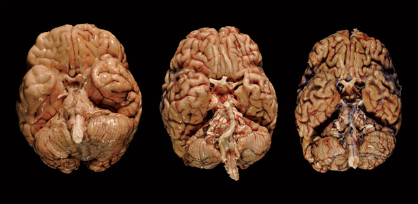The movie 'Concussion', released in February this year, tells the story of Dr Bennet Omalu and his battle against the National Football League (NFL).
Omalu, a Nigerian-born American pathologist, identified severe neurodegeneration in the brains of former football players. He informed the NFL, expecting they would welcome the news, and was met with strong opposition.
Dr Omalu's story is one we're glad to see being told. He has given a huge amount of time and effort to the scientific exploration of brain injury, which several of our own researchers are investigating.
Without any spoilers, we thought this would be the perfect opportunity to refresh your memory on concussion, to give you some information about what is happening in the brain during concussion, and to explain what the deal is with Dr Omalu's discovery: Chronic Traumatic Encephalopathy.
Concussion occurs when force is exerted on your brain, this only really happens in two situations: when your head collides with an object (or an object collides with your head), and when your head accelerates or decelerates too quickly. In New Zealand the two major causes of concussion are sports, and car accidents.
Your brain is made up of billions of tiny cells, some of which have projection fibres that extend from one side of your brain to the other so that different areas can communicate. When this force hits your brain those thin fibres get stretched, which makes some of them tear and others snap completely, harming that communication. These little cells need to generate positive and negative charges in order to send information. But when they get stretched they lose their charge as if a battery has gone flat. This is why some people lose consciousness after a concussion, and why feelings of confusion and disorientation are so common; the brain isn't working properly, it needs more time to recover and recharge.
After concussion most people will experience a headache, dizziness, disorientation, confusion and/or nausea. These feelings usually go away within 24 hours, but the aftereffects of concussion can last for up to three months. During that time people can experience difficulty with sleep, loss of control over their emotions, and memory problems. Fatigue is a major issue for people after concussion, to the point where some people find it difficult to return to work during this time.
Throughout this whole process the brain is still trying to heal. Cells that were damaged too badly are eaten up, and their connections are taken over by other cells. The cells which had tearing will slowly repair those tears. It's important during this time to be extra careful with your head, another concussion would be significantly worse than the first one.
Most people won't really be affected by their concussion in the long-term. Some people will experience lingering symptoms of fatigue or emotional problems, but for most people the last of those symptoms dissipate after three months or so. The real issue arises when people experience multiple concussions, or have concussive hits to the head while still recovering from concussion. This can be a problem in contact sports.
Dementia pugilistica, also known as 'punch drunk syndrome', is dementia caused by repeated hits to the head. This decay of the brain is believed to be caused by repeated trauma to the brain, the result of the brain hitting against the rigid interior of the skull and swelling again and again. This trauma is more severe than concussion, much easier to police, easier to control because you can see it happen. A boxer is punched in the face and falls unconscious. But when a rugby player is tackled and hits the ground, trauma may have occurred but in this case, no one may have noticed.

Photo credit: National Geographic
So when Chronic Traumatic Encephalopathy (CTE) was discovered by Dr Omalu the people in charge, the NFL, denied it could happen. CTE is a form of neurodegeneration caused by non-traumatic concussions. The repeated concussions cause a protein called Tau to build up in the brain, stopping cells from being able to communicate with one another.
The results can be devastating, with young men in the prime of their lives suffering through the symptoms of severe dementia. These individuals experience memory problems, mood swings, and physical impairments. Many of them also die young, in their thirties and forties, from complications associated with CTE or by taking their own lives.
So, what are we doing to protect our players here? In New Zealand we're pretty good at this. Concussion guidelines are built into the game and limit the chance of repeat injuries during recovery. The ACC has released a comprehensive pocket-guide describing how to identify concussion. There is no way to protect people completely and there is no sure way to know who will develop CTE and who will not, but it is important that we minimise the risk.
Research is still needed in the field to try and figure out whether recovery from concussion is ever really complete, and what exactly causes the build-up of Tau in CTE. Researchers here at the BHRC are doing their part in discovering the impacts of brain injury on people of all ages, and we are excited to see how their research will fit in with this developing field.
If you are interested in learning more about concussion come along to our public lecture 'Getting Active After Concussion' during brain week. The event is on Wednesday 16th March from 1pm to 2:30pm at 283 Moray Place.
In the meantime be safe and be kind to your brain.
